I fear that the memory of Baywatch the TV show has been reduced to chuckles about the real-life mundanity of lifeguarding, David Hasselhoff’s tan/borderline-charred body, slow-motion beach running, and a theme song that’d make Kenny Loggins say, "Guys, chill." Just watch the trailer for Baywatch the movie, which comes out on Thursday. It’s all jokes about the literal, limited jurisdiction of lifeguards — "Everything you guys are talking about sounds like a really entertaining but far-fetched TV show," Zac Efron’s character says, oh so self-awarely — and the optical illusions of a pretty girl running along the ocean shore.
Baywatch deserves those shots, but don’t you know that the show was so much more than its most iconically cheesy parts? That in between saving people from pirates was a family drama about a single dad and his son, a soap opera about intraoffice romance, a modern-day noir about a town curiously filled with murderers, and a frivolous tour guide to beach living? That it is a hallmark of ’90s culture, watched by an estimated 1 billion people across 142 countries between 1990 and 1996? Here’s a crash course on Baywatch, so that you may never denounce the upcoming movie as too ridiculous.
"Sea of Flames" (Season 2, Episode 15)
The One Where: Baywatch investigates drug runners
Why It Matters: We have to address the obvious joke about absurd lifeguard vigilantism that courses through the Baywatch movie. In the film, a police officer repeatedly reminds Dwayne Johnson and Efron that lifeguards don’t fight crime, but Baywatch the show consistently featured episodes where detectives openly worked with Mitch Buchannon’s (Hasselhoff) crew. In "Sea of Flames," a new drug called spice — which, to Baywatch’s credit as prognosticator, became a real thing — is hitting the beach and causing amateur fire breathers to burn down lifeguard towers.
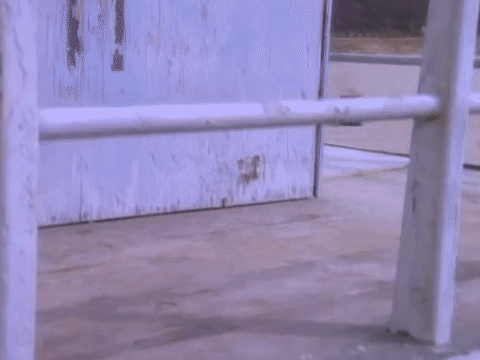
You can’t have that in L.A. County.
Anyway, investigating officer Detective Lyle Connors conducts most of his work out of the Baywatch headquarters because … the drug’s popularization inadvertently affected a lifeguard? I don’t know, I got nothing. But I’m pretty sure wholesale drug operations are a job for actual authorities. In fact, this Lyle Connors character probably isn’t even qualified to investigate this situation. Shouldn’t he have called the DEA? Instead, one of Mitch’s men leads a raid on the boat that’s been smuggling spice onto shore, while Mitch goes on a Jet Ski chase to apprehend the remaining bad guys. AS LIFEGUARDS DO.
This episode is also noteworthy because of its B plot, in which older lifeguard Ben Edwards falls in love with an old Hollywood starlet who moves into a beach house. Hollywood’s purported obsession with the Baywatch team is a theme that the show revisits constantly.
"If Looks Could Kill" (Season 2, Episode 11)
The One Where: Mitch falls for a woman he rescues, and then learns that she’s a murderer
Why It Matters: Saving people from drowning was usually only the inciting action in Baywatch episodes; it would lead to a doomed love affair, or an entanglement with a notorious con artist. In "If Looks Could Kill," Mitch catches feelings after resuscitating Allison Fowles (played by ’80s icon Shannon Tweed), who drove off a cliff into the ocean — a serious hazard of the job, I imagine. "There’s no one I feel safe with — except my lifeguard," Allison says, really giving off those "Mary Astor in The Maltese Falcon" femme fatale vibes. Also: "What do they say in China? ‘You saved my life, so you belong to me’?" She and Hoff smooch, and then smooch even more in a very awesome hot-tub-and-regular-bathtub-involved love-making montage:
And then they go sailing:
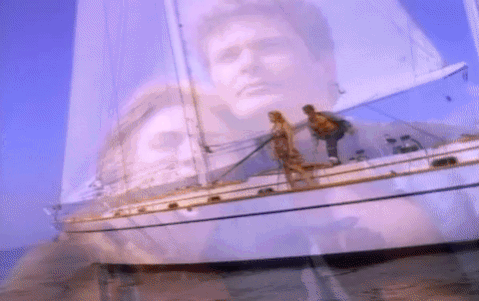
Obviously it becomes increasingly clear that this woman murders people, but true to the noir genre, Mitch can’t see the truth until the very last second, when trusty old Detective Connors lays out the undeniable facts. Mitch then tracks her down on the high seas and takes her into custody (again, not his job, but whatever).
These soap-opera-style episodes defined Baywatch’s style and helped pad out the show as it released 22 episodes for each of 11 seasons. The show did not discriminate when it came to drama and finding ways to keep making Mitch face confrontation. In Baywatch’s run, Hoff’s character fell in love with a murderer, had to persuade the Beach Boys to play a benefit show, and helped an illegal immigrant avoid the authorities — among a trillion other things. If the movie insists on thumbing its nose at the show’s penchant for masquerading lifeguards as law enforcement, then hopefully it’ll at least lean into its predecessor’s incredible flair for the dramatics.
"Windswept" (Season 7, Episode 4)
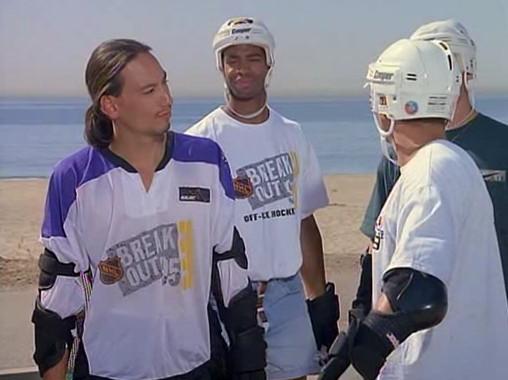
The One Where: The lifeguards play roller hockey
Why It Matters: For all of the heroics and burning boats and fire-breathing drug addicts, once in a while Baywatch was just a show about enjoying all of the outdoor activities that ’90s Los Angeles had to offer. That means volleyball tournaments (yes, like Top Gun), kayak races, and my favorite, the one time the Baywatch guys played roller hockey. Baywatch was pure escapist garbage — mostly because of the soap-opera plots and off-the-wall action sequences, but also because it showcased a lifestyle that viewers didn’t have access to. The L.A. in Baywatch was a sun-soaked paradise, and the show basically acted as video production for California’s tourism board. (Not dissimilar to how Master of None serves as wish fulfillment today for those who dream of dining in hip Williamsburg restaurants.)
"Windswept" is my favorite example of this kind of Baywatch episode, primarily because of how specifically ’90s it is. In 1992, ABA cofounder Dennis Murphy founded Roller Hockey International, an outdoor league that primarily used players from the NHL’s minors. RHI took place mostly in California and regularly aired on the then-budding new network ESPN2:
Like many fads from the era, professional roller hockey was bright and colorful and largely unnecessary. The RHI died with the decade, officially folding in 2001, but by then Baywatch had already cooked up a plot about lifeguard Cody leading his team to a championship in an NHL-sanctioned tournament. The episode barely features water: It’s just Cody enjoying some friendly competition on a slab of pavement near the beach, which is a helpful reminder that sometimes Baywatch was more about a place and time than the travails of lifeguards. (There looks to be a bit of that in the upcoming movie, as the Rock and Efron appear to compete in a strongman competition.) But most importantly, "Windswept" was just so beautifully ’90s, opening with a two-minute-long ode to roller hockey:
"Eel Nino" (Season 8, Episode 8)
The One Where: Hobie ends up stranded in a cave with an electric eel
Why It Matters: Because Hobie, Mitch’s son, sucks. Through 11 seasons, the character causes more problems for Mitch, Baywatch, and the county of Los Angeles than all of the pirates, drug dealers, and drunk college kids combined. In Season 1 alone his stupidity ignites conflict in eight of 22 episodes — 36 percent of the season. He runs away from home and is captured by pirates, he gets tricked by girls he falls in love with, he’s bad at school — the list goes on and on! And it only gets worse as he grows up — that’s when he cops a charge for vehicular manslaughter for getting wasted and crashing a boat with his college friends and GETS HIS TONGUE PIERCED.
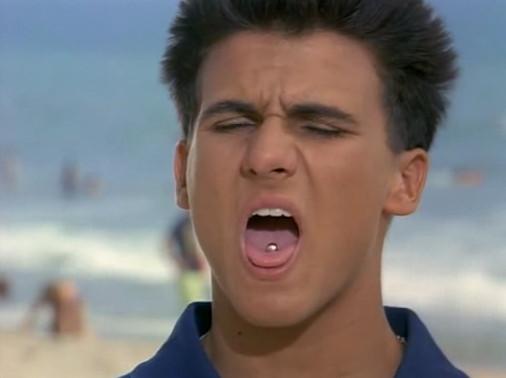
Hobie is an all-time doofus with hardly any character growth, despite aging a decade on the show. "Eel Nino" is the quintessential example for this, because "getting trapped by an eel" is quite possibly the lamest thing that happens to any character on Baywatch. And of course he just sits on the sideline while his dad kills the eel with a defibrillator:
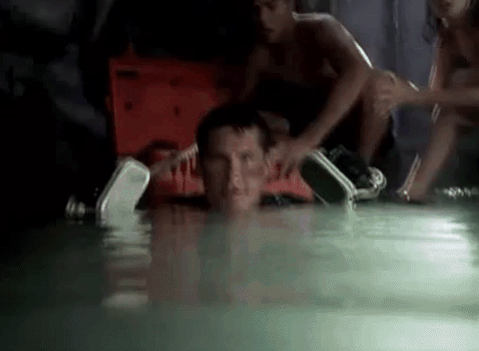
I’m so mad at Hobie for being Hobie. By all accounts, the Rock does not have a son in Baywatch, which is really too bad — it would’ve been a nice hat tip to the series to have the Rock be repeatedly and sorely disappointed by his only child. Maybe they’ll do that on a smaller scale with Efron’s character, or Jon Bass, who appears to be playing a less-than-apt lifeguard.
There — now you know everything one needs to know to qualify as a Baywatch scholar. Welcome to the team. Pray that the Rock fights an eel with hospital appliances in the movie.
